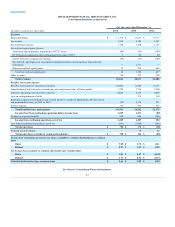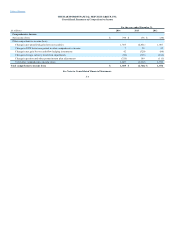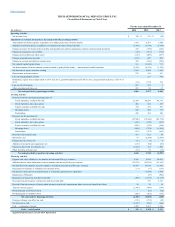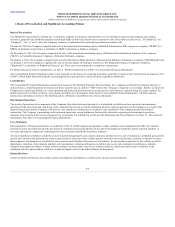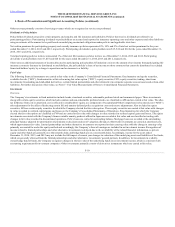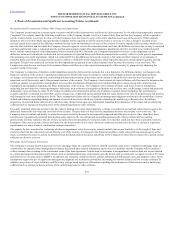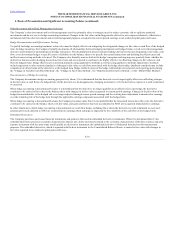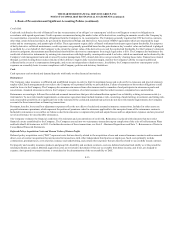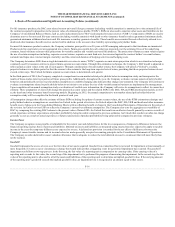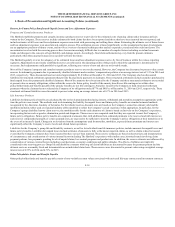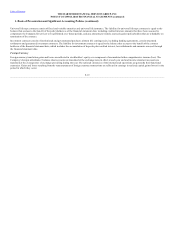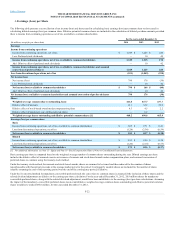The Hartford 2014 Annual Report Download - page 147
Download and view the complete annual report
Please find page 147 of the 2014 The Hartford annual report below. You can navigate through the pages in the report by either clicking on the pages listed below, or by using the keyword search tool below to find specific information within the annual report.
Table of Contents
For mortgage loans that are deemed impaired, a valuation allowance is established for the difference between the carrying amount and the Company’s share
of either (a) the present value of the expected future cash flows discounted at the loan’s effective interest rate, (b) the loan’s observable market price or, most
frequently, (c) the fair value of the collateral. A valuation allowance has been established for either individual loans or as a projected loss contingency for
loans with an LTV ratio of 90% or greater and consideration of other credit quality factors, including DSCR. Changes in valuation allowances are recorded in
net realized capital gains and losses. Interest income on impaired loans is accrued to the extent it is deemed collectible and the loans continue to perform
under the original or restructured terms. Interest income ceases to accrue for loans when it is probable that the Company will not receive interest and principal
payments according to the contractual terms of the loan agreement. Loans may resume accrual status when it is determined that sufficient collateral exists to
satisfy the full amount of the loan and interest payments, as well as when it is probable cash will be received in the foreseeable future. Interest income on
defaulted loans is recognized when received.
Net Realized Capital Gains and Losses
Net realized capital gains and losses from investment sales are reported as a component of revenues and are determined on a specific identification basis. Net
realized capital gains and losses also result from fair value changes in fixed maturities and equity, securities for which the fair value option was elected, and
derivatives contracts (both free-standing and embedded) that do not qualify, or are not designated, as a hedge for accounting purposes, ineffectiveness on
derivatives that qualify for hedge accounting treatment, and the change in value of derivatives in certain fair-value hedge relationships and their associated
hedged asset. Impairments and mortgage loan valuation allowances are recognized as net realized capital losses in accordance with the Company’s
impairment and mortgage loan valuation allowance policies previously discussed above. Foreign currency transaction remeasurements are also included in
net realized capital gains and losses.
Net Investment Income
Interest income from fixed maturities and mortgage loans is recognized when earned on the constant effective yield method based on estimated timing of
cash flows. The amortization of premium and accretion of discount for fixed maturities also takes into consideration call and maturity dates that produce the
lowest yield. For securitized financial assets subject to prepayment risk, yields are recalculated and adjusted periodically to reflect historical and/or estimated
future repayments using the retrospective method; however, if these investments are impaired, any yield adjustments are made using the prospective method.
Prepayment fees on fixed maturities and mortgage loans are recorded in net investment income when earned. For equity securities, dividends will be
recognized as investment income on the ex-dividend date. Limited partnerships and other alternative investments primarily use the equity method of
accounting to recognize the Company’s share of earnings; however, the Company also uses investment fund accounting applied to a wholly-owned fund of
funds. For impaired debt securities, the Company accretes the new cost basis to the estimated future cash flows over the expected remaining life of the
security by prospectively adjusting the security’s yield, if necessary. The Company’s non-income producing investments were not material for the years
ended December 31, 2014, 2013 and 2012.
Derivative Instruments
Overview
The Company utilizes a variety of over-the-counter ("OTC") derivative investments, including transactions cleared through a central clearing house ("OTC-
cleared"), and exchange-traded derivative instruments as part of its overall risk management strategy. The types of instruments may include swaps, caps,
floors, forwards, futures and options to achieve one of four Company-approved objectives: to hedge risk arising from interest rate, equity market, credit
spread and issuer default, price or currency exchange rate risk or volatility; to manage liquidity; to control transaction costs; or to enter into synthetic
replication transactions.
Interest rate, volatility, dividend, credit default and index swaps involve the periodic exchange of cash flows with other parties, at specified intervals,
calculated using agreed upon rates or other financial variables and notional principal amounts. Generally, little to no cash or principal payments are
exchanged at the inception of the contract. Typically, at the time a swap is entered into, the cash flow streams exchanged by the counterparties are equal in
value.
Interest rate cap and floor contracts entitle the purchaser to receive from the issuer at specified dates, the amount, if any, by which a specified market rate
exceeds the cap strike interest rate or falls below the floor strike interest rate, applied to a notional principal amount. A premium payment is made by the
purchaser of the contract at its inception and no principal payments are exchanged.
Forward contracts are customized commitments that specify a rate of interest or currency exchange rate to be paid or received on an obligation beginning on
a future start date and are typically settled in cash.
Financial futures are standardized commitments to either purchase or sell designated financial instruments, at a future date, for a specified price and may be
settled in cash or through delivery of the underlying instrument. Futures contracts trade on organized exchanges. Margin requirements for futures are met by
pledging securities or cash, and changes in the futures’ contract values are settled daily in cash.
F-12


